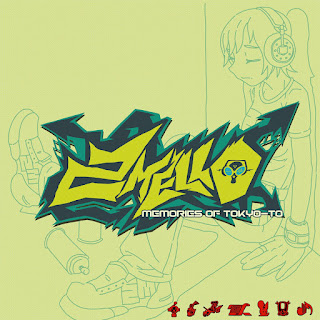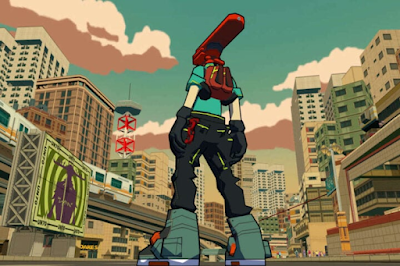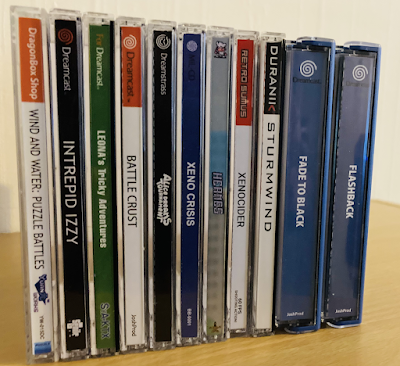Jet Set Radio (or as it was known in North America, Jet Grind Radio) came skating onto the scene in the year 2000. Developed by Sega's in-house studio Smilebit, the flagship Dreamcast release saw players enrol in the rollerblading GGs gang to claim their turf back from their rivals, one graffiti tag at a time, all whilst evading the clutches of the law. A platformer at heart, JSR was fun gameplay-wise, but what kept me and many others coming back for more was undoubtedly its revolutionary cel-shaded graphics, along with its premise, style and music - all a loving tribute to hip-hop and street culture. The exceptional soundtrack, the majority of which was composed by Hideki Naganuma, combined elements of hip-hop, J-pop, funk, electronic dance, rock, acid jazz, and trip-hop, and has been lauded by fans the world over to the point where it's almost taken on a life of its own outside of the game.
 |
| North American magazine ad for Jet Grind Radio |
In the years following Jet Set Radio's release, Sega stopped making consoles and moved to being a third-party developer. Initially things were pretty good, with a wide range of their IPs receiving new titles or reboots, including Jet Set Radio, which received a beloved sequel/re-imagining on the original Xbox in the form of 2002's Jet Set Radio Future.
But, with series developers Smilebit closing their doors in 2004, and Sega's attention to any IP that wasn’t Sonic slowing to a drip feed over the following decade, the possibility of a new entry into the JSR series became less likely with each passing year. We did see a HD remaster during the seventh generation, which was cool, but the fully fledged third instalment many players have been waiting for just never happened.
 |
| The album cover for 2 Mello's "Memories of Tokyo-To" |
During the series' absence, a cult community of fans slowly began to form around Jet Set Radio, with its art style and music finally being appreciated for how excellent it really is. A fan developed a whole website to stream JSR tunes 24/7, while artists like 2 Mello made entire albums in the style of the JSR sound. Many new indie titles like Umarangi Generation and Hover aimed to emulate that funky cel-shaded feeling we were sorely missing. Seeing this community of fans and creators blossoming around JSR really got me thinking... with the series' strongest suit undoubtedly being its aesthetic style and music, and with aspects such as the story and character's personalities taking a backseat (with perhaps the exception of DJ Professor K), it made me wonder: could someone else make Jet Set Radio? We'd witnessed it in the indie space for years, with titles like Bloodstained: Ritual of the Night, Shovel Knight and Cities: Skylines filling the void left behind by the neglect of bigger developers. For me, Jet Set Radio’s best asset is not that it was made by Sega. Sure, the genius minds of Dreamcast-era Sega gave it its best assets, but the fact that Jet Set Radio's winning formula has been abandoned for so long, that it hasn't had the chance to be developed further, to become bigger and better with the power of modern systems, to be re-introduced to a new generation of gamers, is criminal, frankly. As long as the right people were involved, Jet Set Radio could come back in style, even if it meant sacrificing the name.
 |
| Lethal League Blaze |
The answer to my prayers came in 2020, when Dutch indie developer Team Reptile teased Bomb Rush Cyberfunk. Having previously worked on Lethal League, an excellent series of fighting games that feature cel-shading and character designs reminiscent of Jet Set Radio, and with the second game, Lethal League Blaze, even featuring a song from Hideki Naganuma, it was no surprise that Team Reptile were going to attempt a spiritual successor to Jet Set Radio for their next release. From their short teaser alone, I immediately knew they were the right people for the job. Bomb Rush Cyberfunk looked so much like a new Jet Set Radio game that I would've forgiven you for thinking it was made by Sega themselves. The teaser even featured a Naganuma track. It was finally happening!
Despite this, I still saw a fair amount of scepticism online. Some loyalists said they'd just wait for Sega's Jet Set Radio. Some even went as far as to accuse Team Reptile of "plagiarism". C'mon guys, it has been more than 20 years since Sega released an original entry into the Jet Set Radio series. To bastardise that famous lyric from John Lennon:
"All we are saying is, give Bomb Rush Cyberfunk a chance"

On the day it released, I bought Bomb Rush Cyberfunk for the Nintendo Switch, as that was the only console it was available for initially, and I don’t have a gaming PC, so that option was out. From the outset, the game's cel-shaded look, music and sound effects all felt familiar to me. It was great to jump back into that grinding and tagging gameplay I loved so much, to be transported right back to those special moments of playing the original JSR and Future for the first time. But Bomb Rush Cyberfunk is quick to remind you that while it remains incredibly faithful to its source material, it isn't completely derivative of it. Instead, Team Reptile are here to build and improve, which is exactly what I wanted to see from a spiritual successor to Jet Set Radio. I've always sung the praises of the gameplay refinements that Jet Set Radio Future introduced to the series, and Bomb Rush Cyberfunk is no different, picking up where that game left off but now with the benefit of twenty years of hindsight in its arsenal. Throughout this review, I will be calling back to JSR and Future many times to explain how BRC successfully builds on - or even improves - the formula, but please don't understand this as me disparaging the JSR series at all. Both Jet Set Radio and Jet Set Radio Future will forever remain two of my most favourite games of all time.

Bomb Rush Cyberfunk's plot, while still containing the appropriate dose of hip-hop and street culture references you'd expect, is crazy, and immediately more involved than either of the JSR games. Rather than functioning as stylish avatars for your rollerblading escapades, the main set of characters of the Bomb Rush crew have unique personalities and converse with each other in cutscenes, much of which is humorous and often eccentric. The main character, Red, has a purpose - to get his head, which was chopped clean off his shoulders in the game's prologue, back, while also looking to investigate the past of his replacement head (I said the plot was crazy, didn't I?).
The rival crews, still serving as your opponents throughout the game, also have more purpose in the plot, as Red and his crew not only look to defeat them to become "All City" (to claim all turf in the city), but also to gain information to aid in their hunt for Red's origins. While I won't spoil the plot here, all I'll say is the whole idea of Red being a character patched together from the body and head of two different characters, and the duality that brings, is one of the more refreshing plot ideas I've had the pleasure of experiencing in a video game as of late. There are plenty of surprising twists and turns you may not have been expecting from a game that many will be turning to primarily for its aesthetic qualities, and it is certainly refreshing to see.

Bomb Rush Cyberfunk's cast of characters are all varied in design and dripping with style, with their clothing combining the aesthetics and fashion of not only hip-hop and its b-boy subculture, but also the skate culture of the early 2000s, with some sci-fi flair thrown in for good measure. Characters like Red, with his crimson "cyberhead", and the angel-winged crash dummy Solace stand out as the coolest of the bunch, while story characters like the "oldheads" are more amusing, looking like caricatures of golden age hip-hoppers with their maroon tracksuits and over-sized Kangol-esque hats. One of them even has a cyberhead that looks suspiciously like the mask of the late MF DOOM. DJ Cyber's cold cybernetic mask and long stylised lab coat really set him apart as the menacing antagonist he is and the Dot EXE crew just look fresh as hell with their pool ball cyberheads and two stripe tracksuits. Team Reptile really knocked it out of the park when it came to matching the imaginative character design seen in the games BRC takes influence from, so much so that you will undoubtedly be searching around the game's city to track down more peeps to add to your posse.
Depending on how you look at it, one potential flaw of BRC's playable characters could be that none of them have any stats, meaning that your decision on who to play as solely comes down to how cool you think they look. Jet Set Radio did assign stats to each character, which meant there was a bit of strategy involved when making your choice of whom to tackle a particular level with, but I suppose ultimately it's probably better to be able to play as your favourite character without their weaker stats holding back your enjoyment, and it does feel great to be able to constantly switch between BRC's aesthetically pleasing cast of characters just 'cause.
So we've got a great storyline and some cool characters, but how's the gameplay?



















































